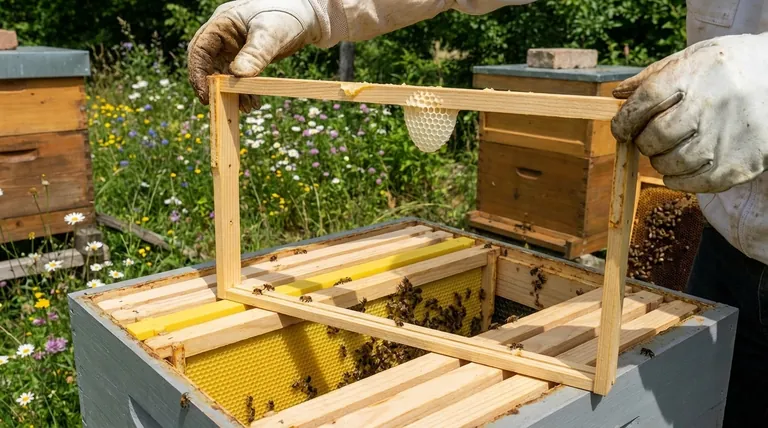The most reliable method for beginners starting with foundationless frames is to not go all-in at once. You should alternate your foundationless frames with frames that have a pre-made foundation. This strategy provides a crucial guide for your bees, dramatically reducing the risk of major comb-building mistakes while you learn.
Foundationless beekeeping offers a natural and cost-effective approach, but it requires giving bees clear guidance to prevent an unmanageable hive. For a beginner, the key is to provide structure by alternating frames, creating a "best of both worlds" scenario.

Why Beginners Are Drawn to Foundationless Frames
Embracing Natural Bee Behavior
Foundationless frames give bees the freedom to build comb with cell sizes they determine are needed for their colony. This mimics their natural process and is a core principle for many who prefer a more natural style of beekeeping.
A Cost-Effective Advantage
One of the most practical benefits is cost. By not purchasing wax or plastic foundation for every frame, you can significantly reduce the startup and ongoing costs of your apiary.
Ideal for Comb Honey Production
If you plan to sell or consume comb honey, foundationless frames are the ideal choice. The lack of a central foundation sheet allows you to cleanly cut a perfect section of honey-filled comb directly from the frame.
The Beginner's Blueprint: Preventing Cross Comb
The Alternating Frame Strategy
The single most important technique is to place a foundationless frame directly between two frames that have foundation. The established frames act as straight, parallel guides, encouraging the bees to build their new comb neatly within the empty frame.
Provide a Clear Starting Point
Bees need a hint for where to start building. You can easily create a starter strip by placing a popsicle stick or a small, one-inch strip of wax foundation into the groove at the top of the foundationless frame. This gives them a perfectly straight line to follow.
Ensure Your Hive is Perfectly Level
Bees build their comb perpendicular to the ground. If your hive is tilted, even slightly, they will build their comb straight down, causing it to angle across the frame and into the neighboring frame's space.
Conduct Frequent Early Inspections
When starting a new box with foundationless frames, check on the bees' progress every few days. If you see comb starting to go crooked, you can gently push it back into place. Correcting a small error early is much easier than fixing a major one later.
Understanding the Trade-offs
The Primary Risk: Cross Comb
Without proper guidance, bees may build comb across multiple frames, effectively fusing them into a single, immovable block. This makes hive inspections impossible without destroying the comb and stressing the colony. Alternating frames is your best defense against this.
Comb Fragility and Honey Extraction
Natural comb is far more delicate than comb reinforced with a plastic foundation. If you plan to use a centrifugal extractor for honey, unsupported comb will likely tear apart. Beekeepers who extract from foundationless frames often install support wires within the frames first.
A Slower Initial Build-Out
Drawing fresh comb from scratch is an energy-intensive process for bees. A colony may take longer to build out a full box of foundationless frames compared to simply drawing out cells on a pre-existing foundation.
How to Apply This to Your Goal
Before you begin, it's crucial to align your methods with your ultimate goal for the hive.
- If your primary focus is natural beekeeping with minimal risk: Start by alternating foundationless frames with foundation frames in your first brood box.
- If your primary focus is producing comb honey: Dedicate a honey super entirely to foundationless frames, as this makes cutting clean sections simple.
- If your primary focus is liquid honey extraction: Be prepared to either install support wires in your foundationless frames or use a crush-and-strain method.
By providing clear initial guidance, you empower your bees to build the strong, natural hive you envision.
Summary Table:
| Strategy | Key Action | Benefit |
|---|---|---|
| Alternating Frames | Place foundationless frames between frames with foundation. | Provides a straight guide for bees, preventing cross comb. |
| Starter Strip | Add a popsicle stick or wax strip to the top bar groove. | Gives bees a clear starting point for building straight comb. |
| Level Hive | Ensure the hive is perfectly level. | Prevents bees from building comb at an angle across frames. |
| Frequent Inspections | Check progress every few days in a new box. | Allows for early correction of minor comb-building mistakes. |
Ready to build a strong, natural hive with confidence?
As a beginner, having the right equipment is crucial for your foundationless beekeeping success. HONESTBEE supplies commercial apiaries and beekeeping equipment distributors with high-quality, wholesale-focused beekeeping supplies.
We provide the durable frames and essential tools you need to implement the alternating frame strategy effectively. Let us help you equip your apiary for a thriving, manageable hive.
Contact HONESTBEE today to discuss your wholesale needs and get started on the right foot!
Visual Guide

Related Products
- Wooden Bee Hive Frames for Beekeeping and Wholesale
- Copper Bee Frame Eyelets for Beekeeping
- Professional Galvanized Hive Strap with Secure Locking Buckle for Beekeeping
- Heavy-Duty Nylon Beehive Hive Strap with Stainless Steel Cinch Buckle
- Stainless Steel Manual Honey Press with Guard for Pressing Honey and Wax
People Also Ask
- What is the role of oxalic acid in plants? A Key to Plant Defense and Internal Regulation
- When should I throw away my bee frames? A Guide to Proactive Hive Health
- What is the recommended number of frames for a beginner beekeeper? The Essential Rule for a Healthy Hive
- What are the standard sizes of frames used in Langstroth hives? Choose the Right Frame for Your Apiary
- What parts of bee equipment should not be painted? Protect Your Hive's Interior for Bee Health



















